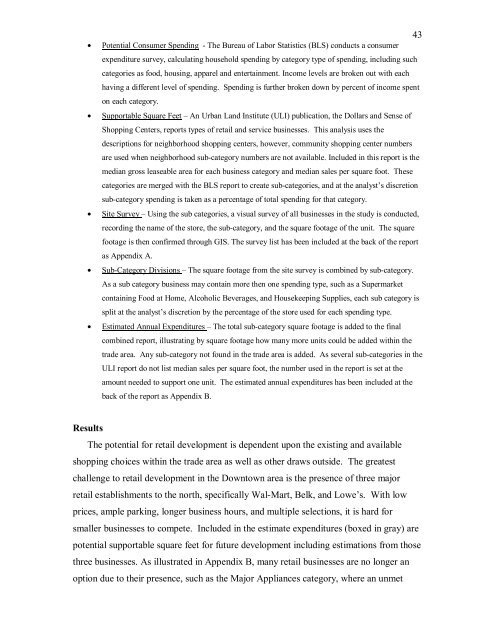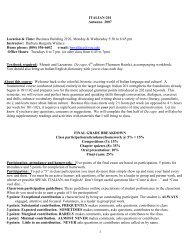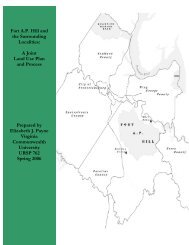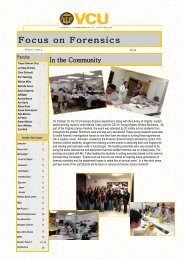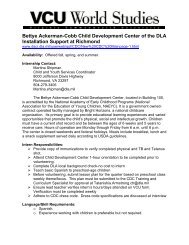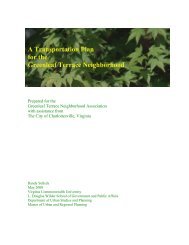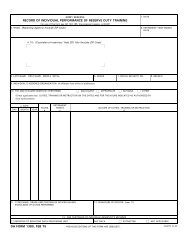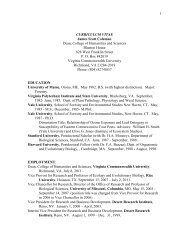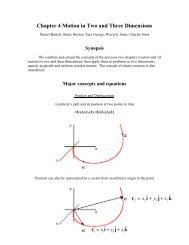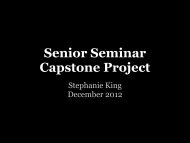Downtown Suffolk Revitalization Plan through Arts - College of ...
Downtown Suffolk Revitalization Plan through Arts - College of ...
Downtown Suffolk Revitalization Plan through Arts - College of ...
You also want an ePaper? Increase the reach of your titles
YUMPU automatically turns print PDFs into web optimized ePapers that Google loves.
43<br />
• Potential Consumer Spending - The Bureau <strong>of</strong> Labor Statistics (BLS) conducts a consumer<br />
expenditure survey, calculating household spending by category type <strong>of</strong> spending, including such<br />
categories as food, housing, apparel and entertainment. Income levels are broken out with each<br />
having a different level <strong>of</strong> spending. Spending is further broken down by percent <strong>of</strong> income spent<br />
on each category.<br />
• Supportable Square Feet – An Urban Land Institute (ULI) publication, the Dollars and Sense <strong>of</strong><br />
Shopping Centers, reports types <strong>of</strong> retail and service businesses. This analysis uses the<br />
descriptions for neighborhood shopping centers, however, community shopping center numbers<br />
are used when neighborhood sub-category numbers are not available. Included in this report is the<br />
median gross leaseable area for each business category and median sales per square foot. These<br />
categories are merged with the BLS report to create sub-categories, and at the analyst’s discretion<br />
sub-category spending is taken as a percentage <strong>of</strong> total spending for that category.<br />
• Site Survey – Using the sub categories, a visual survey <strong>of</strong> all businesses in the study is conducted,<br />
recording the name <strong>of</strong> the store, the sub-category, and the square footage <strong>of</strong> the unit. The square<br />
footage is then confirmed <strong>through</strong> GIS. The survey list has been included at the back <strong>of</strong> the report<br />
as Appendix A.<br />
• Sub-Category Divisions – The square footage from the site survey is combined by sub-category.<br />
As a sub category business may contain more then one spending type, such as a Supermarket<br />
containing Food at Home, Alcoholic Beverages, and Housekeeping Supplies, each sub category is<br />
split at the analyst’s discretion by the percentage <strong>of</strong> the store used for each spending type.<br />
• Estimated Annual Expenditures – The total sub-category square footage is added to the final<br />
combined report, illustrating by square footage how many more units could be added within the<br />
trade area. Any sub-category not found in the trade area is added. As several sub-categories in the<br />
ULI report do not list median sales per square foot, the number used in the report is set at the<br />
amount needed to support one unit. The estimated annual expenditures has been included at the<br />
back <strong>of</strong> the report as Appendix B.<br />
Results<br />
The potential for retail development is dependent upon the existing and available<br />
shopping choices within the trade area as well as other draws outside. The greatest<br />
challenge to retail development in the <strong>Downtown</strong> area is the presence <strong>of</strong> three major<br />
retail establishments to the north, specifically Wal-Mart, Belk, and Lowe’s. With low<br />
prices, ample parking, longer business hours, and multiple selections, it is hard for<br />
smaller businesses to compete. Included in the estimate expenditures (boxed in gray) are<br />
potential supportable square feet for future development including estimations from those<br />
three businesses. As illustrated in Appendix B, many retail businesses are no longer an<br />
option due to their presence, such as the Major Appliances category, where an unmet


